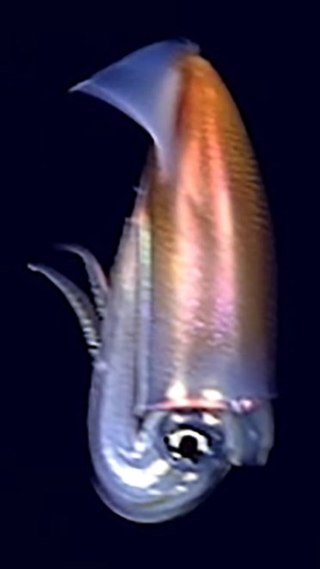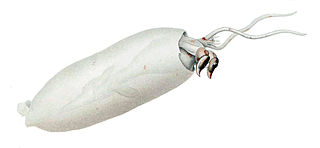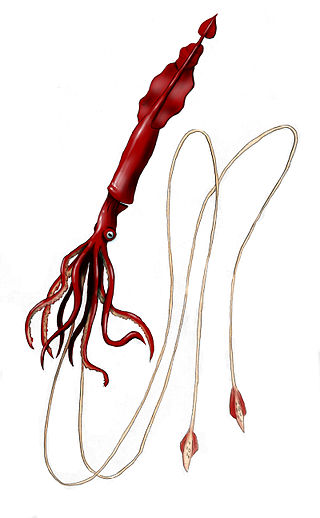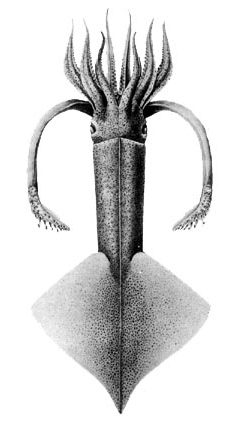
Loliginidae, commonly known as pencil squids, is an aquatic family of squid classified in the order Myopsida.

The Mastigoteuthidae, also known as whip-lash squid, are a family of small deep-sea squid. Approximately 20 known species in six genera are represented, with members found in both the mesopelagic and bathypelagic zone of most oceans. Originally described by Verill in 1881, it was later lowered by Chun (1920) to a subfamily (Mastigoteuthinae) of the Chiroteuthidae. However, Roper et al. (1969) raised it back to the family level, and this has not been changed since. The taxonomy of this family is extremely unstable, and there have been at times one genus, two genera and four subgenera(Salcedo-Vargas & Okutani, 1994), two genera and several 'groups', five genera and one species with an uncertain placement, or six genera.

Walvisteuthis, the stubby hook squids, is a genus of squid in the family Onychoteuthidae. The genus contains four species. They are characterised by possessing oval fins which are not drawn-out posteriorly, the gladius has elongated-rhomboid vanes and a short, blunt rostrum which is perpendicular to tip of gladius, the gladius is visible beneath skin at the dorsal midline and they only have primary occipital folds.

Loligo is a genus of squid and one of the most representative and widely distributed groups of myopsid squid.

Taoniinae is a subfamily containing ten genera of glass squids.

Onykia ingens, the greater hooked squid, is a species of squid in the family Onychoteuthidae. It occurs worldwide in subantarctic oceans.

Onykia robusta, also known as the robust clubhook squid and often cited by the older name Moroteuthis robusta, is a species of squid in the family Onychoteuthidae. Reaching a mantle length of 2 m (6.6 ft), it is the largest member of its family and one of the largest of all cephalopods. The tentacular clubs are slender, containing 15–18 club hooks. Arms of the species contain 50–60 suckers, and grow to 90–100% of the mantle length. It is found primarily in the boreal to Temperate Northern Pacific.

Onychoteuthis banksii, the common clubhook squid, is a species of squid in the family Onychoteuthidae. It is the type species of the genus Onychoteuthis. This species was thought to have a worldwide distribution but with the revision of the genus Onychoteuthis in 2010, it is now accepted that Onychoteuthis banksii is restricted to the central and northern Atlantic and the Gulf of Mexico while a recently described species, Onychoteuthis horstkottei, is found in the Pacific Ocean. The type locality is the Gulf of Guinea.
Moroteuthopsis longimana, also known as the giant warty squid or longarm octopus squid, is a large species of hooked squid. It attains a mantle length of at least 85 cm and probably over 1.15 m. The largest complete specimen of this species, measuring 2.3 m in total length, was found in Antarctica in 2000.
Moroteuthopsis is a genus of squid in the family Onychoteuthidae. The type species is Moroteuthopsis longimana.

Asperoteuthis is a genus of chiroteuthid squid comprising four species:
Alloteuthis africana, also known as the African squid, is a species of squid in the family Loliginidae. This species of squid is restricted to the Guinean province. To identify the Alloteuthis africana from other Alloteuthis congeners, it is highly recommended to measure the width of the squids head and the sucker size.
Filippovia knipovitchi, the smooth hooked squid, is a species of squid in the family Onychoteuthidae and the sole member of the genus Filippovia. It is found in the Antarctic and Atlantic Oceans, and reaches a mantle length of 35 cm.

Onychoteuthis is a genus of squid in the family Onychoteuthidae. The type species is Onychoteuthis bergii. While the genus is found worldwide in tropical and subtropical oceans, they can also occur in the North Pacific Ocean. There were previously considered to be four species in the genus but there are now considered to be roughly 10. These squid are frequently observed in the surface waters at night and they are often caught using dipnet at nightlight stations. The young squid are usually the only specimens captured using standard midwater trawls, the older squid are apparently able to avoid the trawls. They can, however be collected from the air as individuals are able to leap high out of the water, sometimes even landing on the deck of a ship.

Onychoteuthis borealijaponica, the boreal clubhook squid, is a species of squid in the family Onychoteuthidae. It is the largest member of the genus Onychoteuthis, reaching a mantle length of 30 cm in males and 37 cm in females. Maturity is reached at 250 mm for males, and 300–350 mm in females. There are 24–27 hooks on each club, which is more than any other species in the genus Onychoteuthis. It is a pelagic species native to the North Pacific, although it migrates into Subarctic waters during the summer from its more southerly winter spawning grounds.
Onychoteuthis meridiopacifica is a species of squid in the family Onychoteuthidae. Males become mature at 40 mm, and the species is believed to reach a maximum mantle length of 90 mm, the smallest species in the genus Onychoteuthis. The tentacular club reaches a length of 20-25% of the mantle length, and contains 16-19 club hooks. Arms reach 27-44% of the mantle length, and each contain 50-60 suckers. 8-12 nuchal folds are present on each side of the head. Its short, broad fins and the possession of a small number marginal suckers on the tentacular clubs of adults are distinguishing characteristics of this species. It is found off eastern Australia and probably extends into seas off Indonesia as well as east to Tonga and Vanuatu.
Notonykia africanae is a species of squid in the family Onychoteuthidae. It is the type species of the genus Notonykia. While the mature size of the species is unknown, it is known to reach a mantle length of at least 180 mm. Tentacles reach approximately 70% of the mantle length, and contain 14-20 club hooks. Arms are known to reach 27-45% and 33-55% of the mantle length; each containing 50-60 suckers. The species is located in southern waters off Australia, Tasmania, New Zealand and South Africa.
Notonykia is a genus of squid in the family Onychoteuthidae. The type species is Notonykia africanae.

Cephalopods exhibit various dermal structures on their mantles and other parts. These may take the form of conspicuous warts, cushions, papillae or scales, though in many species they are microscopic tubercles. The most elaborate forms are found among the oceanic squid of the order Teuthida.
Onychoteuthis bergii is a species of hooked squid from the family Onychoteuthidae. The species was originally described by Hinrich Lichtenstein from specimens taken near the Cape of Good Hope and is the type species of the genus Onychoteuthis. Until recently it was considered to be a junior synonym of Onychoteuthis banksii, but a re-examination of the type material, the lectotype and paralectotype which are deposited in the Natural History Museum, Berlin, showed that there were morphological differences which supported the status of O. bergii as a valid species. The species is found in the eastern South Atlantic and Indian Oceans.













